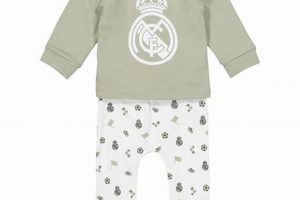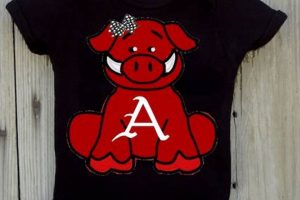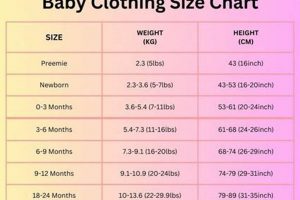Garments designed for infants and young children, irrespective of the child’s sex, are characterized by styles, colors, and patterns that are not traditionally associated with either boys or girls. These items often feature a broad spectrum of colors, including greens, yellows, oranges, and neutrals like beige and gray. Common examples include simple onesies, overalls, t-shirts, and pants with designs such as animals, shapes, or abstract patterns.
Such apparel choices offer several advantages. They promote individuality, allowing children to express themselves beyond societal expectations. Sharing clothing between siblings is facilitated, providing potential cost savings and reducing textile waste. Historically, clothing for young children was more uniform, with differentiation based on gender becoming more prominent in the 20th century; a return to more uniform styles can be viewed as a challenge to established norms and a move towards greater equality.
The subsequent sections will delve into the design considerations, material choices, market trends, and practical implications involved in selecting these versatile and inclusive items for infants and toddlers.
Guidance on Selecting Garments for Infants and Toddlers
The following points provide guidance for selecting appropriate apparel for infants and toddlers, focusing on practicality, comfort, and versatility.
Tip 1: Prioritize Comfort and Safety. Natural fibers, such as cotton and bamboo, minimize skin irritation. Ensure that garments lack small buttons or embellishments that could pose a choking hazard.
Tip 2: Opt for Versatile Styles. Choose garments that can be easily mixed and matched. Bodysuits, leggings, and simple tops in neutral colors offer flexibility and expand wardrobe options.
Tip 3: Select Durable and Washable Fabrics. Infants’ apparel requires frequent washing. Prioritize fabrics that withstand repeated laundering without significant fading or shrinkage.
Tip 4: Consider Practicality for Diaper Changes. Garments with snaps or zippers in the crotch area simplify diaper changes, enhancing convenience for caregivers.
Tip 5: Avoid Overly Restrictive Clothing. Loose-fitting styles promote freedom of movement, supporting healthy development and physical activity.
Tip 6: Pay Attention to Sizing. Infants grow rapidly. Select sizes that allow for growth spurts, or consider adjustable features like roll-up sleeves or elastic waistbands.
Tip 7: Choose Color Palettes Wisely. While individual preferences vary, neutral and muted tones are less susceptible to fading and offer greater versatility in matching with other items.
Adhering to these recommendations fosters informed choices, leading to functional and comfortable wardrobes for infants and toddlers.
The subsequent sections will address long-term considerations regarding sustainability and ethical sourcing in infant apparel.
1. Versatility
Versatility, in the context of infant and toddler apparel that does not conform to traditional gender norms, significantly enhances the practical value and adaptability of a child’s wardrobe. This characteristic facilitates a wider range of usage scenarios and maximizes utility.
- Interchangeability of Items
Garments designed without strict adherence to gendered styles can be easily mixed and matched within a childs wardrobe. This allows for numerous outfit combinations with a smaller number of items, optimizing closet space and simplifying dressing routines. For example, a neutral-colored romper can be paired with various leggings or jackets, irrespective of whether they are traditionally considered “boyish” or “girlish.”
- Suitability for Multiple Occasions
Apparel with neutral designs is often suitable for a variety of settings, from casual playtime to more formal gatherings. A simple, unadorned dress can be appropriate for both a visit to the park and a family dinner. This adaptability reduces the need for specialized clothing for each specific event, promoting resourcefulness and minimizing expenditure.
- Shared Use Among Siblings or Relatives
Clothing that lacks overt gender markers can be easily shared between siblings or passed down to younger relatives, irrespective of their sex. This fosters resource sharing and minimizes the environmental impact associated with frequent clothing purchases. A set of neutral-toned onesies, for example, can be used for multiple infants within a family, extending the lifespan of the items and reducing textile waste.
- Adaptability to Changing Weather Conditions
Versatile garments often incorporate features that allow for adaptation to varying weather conditions. Layering pieces, such as neutral-colored cardigans or lightweight jackets, can be added or removed as needed to maintain comfort in fluctuating temperatures. This adaptability ensures that the child remains appropriately dressed throughout the day, regardless of weather variations.
The multifaceted nature of versatility, when applied to infant and toddler apparel, offers significant benefits in terms of practicality, resourcefulness, and adaptability. This characteristic not only simplifies clothing management for caregivers but also promotes sustainable consumption habits and minimizes environmental impact.
2. Comfort
Garment design and material selection are primary determinants of infant comfort. Apparel made without consideration for established gender norms prioritizes comfort by often employing soft, natural fibers and minimizing restrictive elements. The cause-and-effect relationship is direct: thoughtfully designed, gender-neutral garments enhance infant well-being, whereas ill-fitting or irritating clothing can lead to discomfort and distress. A key component of successfully implemented apparel is freedom of movement; for instance, a loose-fitting cotton romper allows infants to explore and interact with their environment without physical restriction. This practical significance highlights the necessity of considering comfort as an integral aspect of clothing choices.
Furthermore, comfort in infant apparel extends beyond purely tactile considerations. Garments should be easy to put on and take off, minimizing stress during dressing and diaper changes. Snap closures or elastic waistbands provide convenience for caregivers while ensuring that the infant remains comfortable throughout the process. Garments labeled as being without conventional gender coding often promote ease-of-use as a design priority, leading to items that are simple in construction and functional in application.
In summary, comfort is foundational for infant well-being and directly relates to the design of apparel. Prioritizing soft, natural materials, ease of movement, and functional closures are vital considerations. Challenges remain in ensuring that all garments meet these standards, but the understanding of this connection drives demand for more comfortable, versatile, and inclusive clothing options.
3. Durability
Durability is a crucial attribute of infant and toddler apparel, irrespective of gender association. Clothing designed for frequent use and laundering requires robust construction and resilient materials. Garments marketed without specific gender targeting frequently emphasize longevity due to the potential for extended use across multiple children. This emphasis on enduring quality directly impacts the economic and environmental sustainability of clothing consumption.
The practical significance of durable infant apparel is multifaceted. For instance, consider a set of cotton overalls designed with reinforced seams and durable hardware. These garments can withstand repeated washing cycles and the rigors of active play, maintaining their structural integrity over time. This extends the lifespan of the clothing, reducing the frequency of replacements and minimizing textile waste. The increased utility derived from durable items also represents a cost saving for families, particularly when clothing can be passed down between siblings or relatives.
In summary, the relationship between durability and garment design is pivotal for achieving long-term value and sustainability in infant apparel. While challenges exist in balancing durability with affordability and aesthetic appeal, recognizing the inherent benefits of well-constructed, resilient clothing informs responsible purchasing decisions and promotes a more sustainable approach to consumption within the infant and toddler market.
4. Safety
Infant and toddler apparel necessitates stringent safety standards, regardless of its classification. The inherent vulnerability of young children demands meticulous attention to detail throughout the design, manufacture, and distribution processes. Apparel absent of established gender association is subject to these same safety requirements, ensuring child protection.
- Absence of Hazardous Embellishments
Small components, such as buttons, beads, and decorative appliques, pose a potential choking hazard to infants and toddlers. Clothing, irrespective of style or categorization, should be free from such embellishments or securely attached to prevent detachment. The absence of these items is a primary safety consideration. For example, screen-printed designs are preferred over sewn-on elements due to the reduced risk of separation.
- Non-Toxic Materials and Dyes
Fabrics and dyes used in the manufacture of infant apparel must be non-toxic and free from harmful chemicals. Young children frequently mouth or chew on their clothing, increasing the risk of exposure to potentially hazardous substances. Materials meeting certifications like OEKO-TEX Standard 100 indicate compliance with strict safety standards. Garments, regardless of their stylistic intent, require adherence to these material safety guidelines.
- Flame Resistance
While stringent regulations regarding flame retardancy in children’s clothing may vary by region, fabrics with inherent flame-resistant properties are desirable. Lightweight, breathable materials that meet flammability standards offer increased protection in the event of exposure to heat or flame. This consideration applies universally across all apparel categories for infants and toddlers.
- Appropriate Fit and Design
Garments that are either too tight or too loose can present safety concerns. Overly restrictive clothing may impede movement and circulation, while excessively loose garments can pose a risk of entanglement or tripping. Designs should prioritize ease of movement and a secure, comfortable fit. For instance, adjustable features, such as elastic waistbands or snap closures, allow for a customized fit that accommodates growth while maintaining safety.
The overarching principle is that safety considerations are paramount in infant and toddler apparel, superseding stylistic choices or marketing classifications. Adherence to established safety standards is essential to ensure the well-being and protection of young children, regardless of the clothing’s intended aesthetic or perceived gender association.
5. Accessibility
Accessibility, in the context of infant and toddler apparel, refers to the ease with which garments can be acquired, utilized, and adapted to meet the diverse needs of caregivers and children. The absence of gendered design elements in clothing can enhance accessibility by broadening the range of individuals and situations for which the apparel is suitable. The availability of garments free from distinct gender markers can benefit families with limited financial resources, those seeking to reduce consumption, and those who prefer not to reinforce traditional gender norms. Garments designed for broader use and application inherently improve access for a wider demographic. For example, clothing banks or donation centers stocked with apparel suitable for any child, regardless of sex, increase the likelihood that all recipients’ needs will be met.
The practical application of accessible infant apparel extends to children with disabilities or specific sensory sensitivities. Garments with simplified closures, such as Velcro or magnetic fasteners, and seamless constructions reduce potential discomfort and improve ease of dressing for both the child and the caregiver. Neutral designs further facilitate accessibility by allowing for seamless integration of adaptive clothing items into a child’s existing wardrobe, minimizing the visual distinction between necessary modifications and standard garments. This seamless integration promotes inclusivity and reduces potential stigmatization. For instance, a plain, adaptive bodysuit with snap closures can easily be layered beneath existing outer garments without drawing undue attention to its adaptive features.
In summary, the connection between accessible infant apparel and the diminishing of gendered design is a symbiotic one. Facilitating a more inclusive approach to clothing design, production, and distribution positively affects a broader segment of the population. By removing the restrictive elements of traditional gender norms, accessibility is amplified, promoting practical, economic, and social benefits for caregivers and children. This shift necessitates ongoing efforts to diversify designs and improve distribution channels, ensuring that these benefits are fully realized and sustained.
6. Sustainability
The intersection of sustainability and infant apparel, specifically garments designed without reference to traditional gender norms, is characterized by a multifaceted relationship. These garments inherently promote sustainability through reduced consumption. Items designed for use by any child, irrespective of sex, can be shared among siblings or passed down to other families, extending the lifespan of individual articles. A practical example is a set of plain-colored cotton onesies, suitable for both male and female infants, which can be used for multiple children within a family. This reduces the demand for new clothing production, minimizing resource extraction, manufacturing waste, and associated carbon emissions. The importance of sustainability as a component stems from its direct impact on resource conservation and waste reduction, aligning with principles of environmental responsibility.
Moreover, the concept of “gender-neutral” design encourages the use of durable, long-lasting materials. Manufacturers are incentivized to create clothing that withstands extended wear and repeated washing, enhancing the overall sustainability profile of these products. Consider, for instance, a line of infant apparel constructed from organic cotton and dyed with non-toxic, natural dyes. These garments are not only environmentally friendly in their production but also offer improved safety and comfort for the infant. The practical application of this understanding involves consumers making informed purchasing decisions, prioritizing sustainable materials and manufacturing practices over fleeting trends. The impact of this choice resonates through the supply chain, promoting ethical labor practices and minimizing environmental harm.
In summary, the connection between sustainability and infant apparel lies in its promotion of reduced consumption, durable design, and responsible manufacturing practices. Challenges remain in scaling these sustainable practices across the entire industry and combating the influence of fast fashion. However, recognizing the benefits of these design choices informs a more conscious and environmentally responsible approach to clothing consumption, benefiting both present and future generations. As the demand for sustainable options increases, manufacturers are driven to adopt eco-friendly strategies, culminating in a more responsible product life cycle from sourcing to disposal. This collective effort paves the way for a more sustainable future for the apparel industry as a whole.
7. Cost-effectiveness
Cost-effectiveness constitutes a significant consideration in the acquisition and maintenance of infant apparel. Garments designed without specific gender associations often present economic advantages compared to those marketed along traditional gender lines. This stems from several interrelated factors affecting initial purchase price, lifespan, and overall utility.
- Extended Usability Across Multiple Children
Apparel lacking distinct gender identifiers, such as patterns or colors typically associated with boys or girls, can be readily used by multiple children, irrespective of sex. This shared usability extends the lifespan of each garment, reducing the necessity for frequent replacements and diminishing overall expenditure. For instance, a set of neutral-toned onesies can be utilized for subsequent children, irrespective of their sex, thereby maximizing the return on the initial investment. This extended usability directly contributes to lower long-term clothing costs for families.
- Reduced Inventory and Storage Requirements
A wardrobe comprised of items designed for use by both male and female infants simplifies clothing management and storage. Families can maintain a smaller, more versatile collection of garments, reducing the need for extensive storage solutions and minimizing the time and effort associated with sorting and organizing disparate wardrobes. A streamlined inventory is particularly beneficial in households with limited space or resources.
- Mitigation of Gender-Specific Purchasing Biases
Marketing strategies frequently encourage distinct purchasing patterns based on perceived gender norms, leading to the acquisition of items that may be used infrequently or discarded prematurely due to shifting trends. Neutral apparel, conversely, promotes practicality and functionality, mitigating the influence of ephemeral trends and encouraging more deliberate purchasing decisions. This shift in consumer behavior minimizes unnecessary expenditure on items with limited utility.
- Enhanced Resale and Donation Value
Apparel that lacks overt gender markers typically maintains greater resale value and is more readily accepted by charitable organizations or clothing exchange programs. The broader appeal of these items increases the likelihood of finding a buyer or recipient, maximizing the return on investment and promoting resource redistribution. Garments with neutral designs are less likely to be discarded and more likely to find continued use within the community, further contributing to overall cost-effectiveness.
In conclusion, cost-effectiveness is intrinsically linked to apparel that does not conform to traditional gender norms. These garments present economic advantages through extended usability, simplified inventory management, reduced susceptibility to marketing pressures, and enhanced resale potential. The cumulative effect of these factors results in significant cost savings for families and promotes more sustainable consumption patterns within the infant apparel market.
Frequently Asked Questions
The following addresses common inquiries regarding apparel designed for infants, devoid of traditional gender-specific styling.
Question 1: What defines apparel for infants as “gender neutral”?
The designation refers to garments characterized by colors, patterns, and styles not traditionally associated with either male or female infants. This typically encompasses a broad range of colors (greens, yellows, oranges, browns, grays), simple designs, and absence of overtly masculine or feminine embellishments.
Question 2: What are the primary benefits of selecting non-gendered apparel for infants?
Benefits include increased versatility, facilitating sharing between siblings regardless of sex; reduced clothing costs through minimizing the need for separate wardrobes; promotion of individuality, allowing the child to develop personal preferences devoid of societal expectations; and contribution to a more sustainable consumption model through extended garment lifespan.
Question 3: Are there specific safety standards applicable to all infant apparel, including those classified as gender neutral?
All infant apparel, regardless of design or marketing, must adhere to stringent safety standards. These include the avoidance of small, detachable parts posing a choking hazard; the use of non-toxic dyes and materials; and compliance with flammability regulations.
Question 4: How does the durability of non-gendered infant clothing compare to traditionally gendered items?
The durability is contingent upon material selection and construction quality, not the presence or absence of gender-specific styling. Garments constructed from durable materials and employing robust manufacturing techniques offer extended lifespan, regardless of marketing categorization.
Question 5: Does the selection of non-gendered apparel limit design options or aesthetic expression?
The absence of gendered styling expands, rather than restricts, design options. This approach enables exploration of a broader palette of colors, patterns, and textures, fostering creativity and individuality. The emphasis shifts from adherence to predetermined societal norms to personal preference and stylistic innovation.
Question 6: Where can parents or caregivers purchase infant clothing free from traditional gender associations?
Such items are increasingly available through a variety of retail channels, including online marketplaces, specialty boutiques, and mainstream department stores. The selection often includes dedicated sections or curated collections featuring apparel designed with versatility and inclusivity in mind.
In summary, thoughtful selection of infant clothing, prioritizing safety, durability, and versatility, ensures both the child’s well-being and responsible consumption patterns.
The subsequent section explores the evolving market trends and consumer preferences shaping the future of infant apparel.
Concluding Remarks on Baby Gender Neutral Clothes
This exploration has illuminated the multifaceted aspects of baby gender neutral clothes, encompassing design considerations, safety protocols, economic implications, and sustainability factors. The discussion has underscored the potential for these items to promote individuality, reduce consumption, and foster equitable practices within the apparel industry.
Continued awareness and mindful purchasing choices contribute to a shift towards greater inclusivity and responsibility in the market. This evolution signifies a move beyond established norms, prioritizing the well-being and individuality of infants while fostering sustainable consumption habits for future generations. Active participation in this transition ensures a more equitable and ecologically conscious future.







